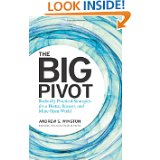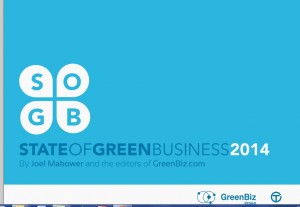Happy first day of April!
To me, April is “Earth month.” While Earth Day is April 22, I hope you plan to celebrate the health of our home planet well beyond just the one day.
One way I celebrate is by reading about both climate change and the ways different businesses address it. I just finished reading Andrew Winston’s new book, “The Big Pivot”.
Andrew is an author, speaker and head of Winston Eco-Strategies. He’s one of the experts I follow on issues around climate change and business. A “pivot” is a turn – a change in direction; and given this headline in the New York Times, we need to make that turn ASAP.
A Super-Condensed Summary: Part 1
The book is definitely worth a read (and no, I don’t get compensated for saying that).
My Earth Day gift to you is to summarize the book (over the next few posts) to give you a sense of what’s covered. If something resonates with you about your business, then you’ll want to invest in a copy.
Today’s 3 Mega Challenges for Business
The first section of the book echoes Tom Friedman’s “Hot, Flat and Crowded” from 2008. But “The Big Pivot” has more recent statistics and stories – from Superstorm Sandy to the Texas drought to Typhoon Haiyan. Clearly, climate impacts on business are just revving up.
Winston calls out these key challenges:
- More business disruption and loss from a hotter climate. Did you know that natural disasters cost the US over $100 billion in 2012 alone?
- Scarcer natural resources that make prices for inputs more volatile and likely to rise. For example, the price of cotton rose from 84 cents to $2.29 per pound between July 2010 and March 2011 – in part due to floods and rain in cotton-producing regions.
- More transparency in business. From cell phone cameras that can document poor working conditions to demands for more information in corporate sustainability reports, businesses face pressure to be clear about what goes into their products and services.
And yet, according to Winston, each challenge also represents a mega-opportunity
- Climate change helps drive the rise of the “clean economy” – a diverse and growing sector of the economy.
- Resource constraints are happening because there’s a huge new global middle class demanding a higher standard of living. Business needs to find sustainable ways to meet those demands.
- Transparency also presents opportunities for businesses to collaborate and innovate in solving climate issues in ways that business can also benefit from.
According to Winston, our current business models aren’t up to these challenges. “We must pivot – sometimes painfully, always purposefully – so that solving the world’s biggest challenges profitably becomes the core pursuit of business.”
Why? Because “it’s ludicrous to prioritize short-term profit at the cost of our very survival.” Agreed.
Tomorrow: Big-Pivot Strategies – The “Vision” Pivot




